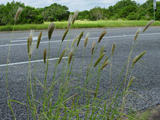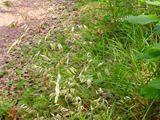Native Plants

Q. Who is Mr. Smarty Plants?
A: There are those who suspect Wildflower Center volunteers are the culpable and capable culprits. Yet, others think staff members play some, albeit small, role. You can torture us with your plant questions, but we will never reveal the Green Guru's secret identity.
Did you know you can access the Native Plant Information Network with your web-enabled smartphone?
Ask Mr. Smarty Plants is a free service provided by the staff and volunteers at the Lady Bird Johnson Wildflower Center.

rate this answer
Tuesday - August 06, 2013
From: Kerrville, TX
Region: Southwest
Topic: Drought Tolerant, Erosion Control, Grasses or Grass-like, Herbs/Forbs, Shrubs
Title: Erosion tolerant plants for shade from Kerrville TX
Answered by: Barbara Medford
QUESTION:
We have just cleared a lot of cedar out of a small draw and would like to know the best groundcovers, shrubs, etc. to plant to hold the soil. Deep shade most of the day.ANSWER:
We just answered a very similar question, with one glaring difference - you are looking for shade plants, which may be a real problem. This time we are going to our full Native Plant Database so we will have more possibilities to choose from. We are in hopes that the draw gets some water from time to time and that will assist us in finding plants for your situation. Please read our similar question first, and then we will go to our database and, using the list of specifications on the right-hand side of the page, select on Texas, then "grass or grass-like" for Habit, "dry" for Soil Moisture and both shade (2 hour or less of sun a day) and "part shade" (2 to 6 hours of sun a day) under Light Requirements. After we run that search, we will run additional searches for the Habits of "shrubs" and "herbs' (herbaceous blooming plants) and see what results we get. We have given you 4 possibillities each for Habit. We suggest, since we really don't know enough about the environment where you propose to grow these plants, that you run the searches for yourself. Each time you select a plant, go to our webpage on that plant, study its light and moisture requirements, then go down the page to Additional Resources. Click on "Find (plant name) in USDA Plants". When you get the map of North America, the green states on that map record that plant as growing natively. Click on Texas and you will get a map with the counties green where that plant grows. This helps us, and we hope it helps you, determine if the soils, climate and rainfall in your area are appropriate to that plant.
Grass or grasslike plants for shade:
Carex planostachys (Cedar sedge)
Chloris virgata (Feather fingergrass)
Melica nitens (Three-flower melic)
Nassella tenuissima (Mexican feathergrass)
Shrubs for Shade:
Acacia angustissima (Prairie acacia)
Aesculus pavia var. pavia (Scarlet buckeye)
Amorpha roemeriana (Roemer's false indigo)
Baccharis neglecta (False willow)
Herbaceous blooming plants for shade:
Ageratina altissima (White snakeroot)
Amblyolepis setigera (Huisache daisy)
From the Image Gallery
More Herbs/Forbs Questions
Care of poppy plants
July 10, 2013 - I bought a tiny poppy grow kit at Target for 99 cents. Amazingly, they have grown into numerous large and very healthy plants, though they don't all appear to be the same species. Some have grown to ...
view the full question and answer
Need recommendations for native plants on a dry sunny hillside in Baltimore Maryland.
July 28, 2009 - Need native recommendations for sunny, dry hillside for ground cover or shrub in Maryland. Mowing the grass is a pain and an energy waster (and I don't want to be tempted to extend some adjacent exi...
view the full question and answer
Cutting back achillea in New York
March 18, 2009 - Last summer I planted three gorgeous hearty achillea with flat, yellow tops, about 3 feet high or more each, in my sunny garden. But after they were done flowering, I left those very pretty brown stem...
view the full question and answer
Need suggestions for native grasses to stabilize hillside Kerrville, TX.
August 18, 2012 - We have a steep slope at the back of our property in "caleche" territory in Kerrville. It is about 80 feet wide by 40 feet and ends at a wash. It is outside of our fenced yard and we are in city lim...
view the full question and answer
Establishing wildflowers on a slope in Virginia
August 18, 2012 - From Roanoke Virginia. I have a steep bank rising from one side of my driveway to woods above. Different areas vary from full sun, to half day shade. It is possible to carefully walk/stand on it, we a...
view the full question and answer
| Support the Wildflower Center by Donating Online or Becoming a Member today. |


